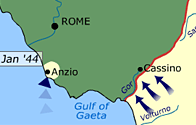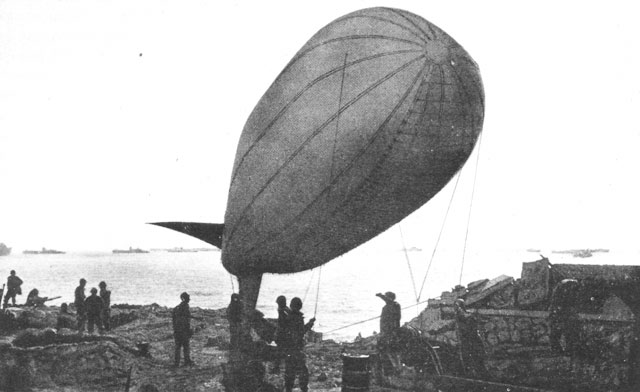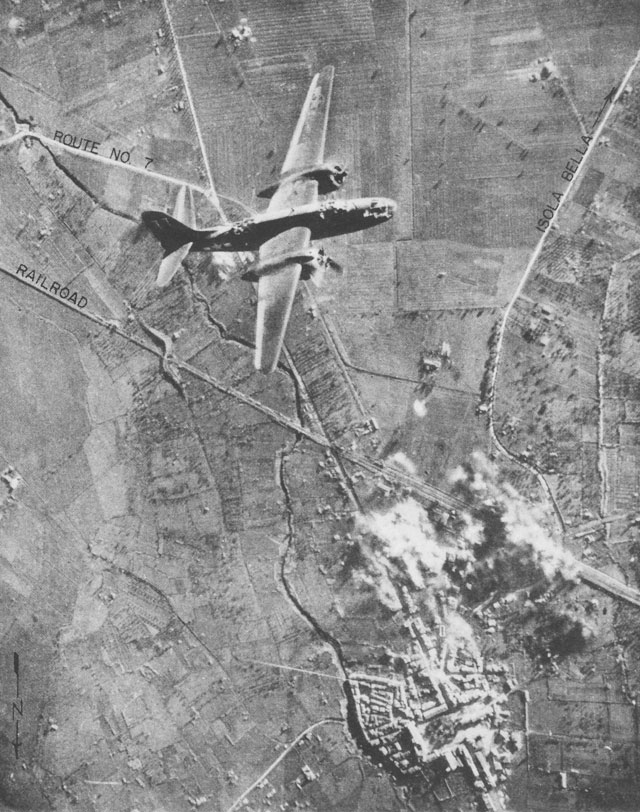
click to see a BBC campaign ani

 click to see a BBC campaign ani |

|
Anzio : Operation Shingle
The Anzio invasion began at 0200 on 22 January 1944 and achieved, General Lucas recalled, one of the most complete surprises in history. The Germans had already sent their regional reserves south to counter the Allied attacks on the Garigliano on 18 January, leaving one nine-mile stretch of beach at Anzio defended by a single company. The first Allied waves landed unopposed and moved rapidly inland. On the southern flank of the beachhead the 3d Division quickly seized its initial objectives, brushing aside a few dazed patrols, while unopposed British units achieved equal success in the center and north. Simultaneously, Rangers occupied Anzio, and the 509th Parachute Infantry Battalion seized Nettuno. All VI Corps objectives were taken by noon as the Allied air forces completed 1,200 sorties against targets in and around the beachhead. On the beach itself, the U.S. 36th Engineer Combat Regiment bulldozed exits, laid corduroy roads, cleared mines, and readied the port of Anzio to receive its first landing ship, tank (LST), an amphibious assault and supply ship, by the afternoon of D-day. By midnight over 36,000 men and 3,200 vehicles, 90 percent of the invasion force, were ashore with casualties of 13 killed, 97 wounded, and 44 missing. During D-day Allied troops captured 227 German defenders.
Allied units continued to push inland over the next few days to a depth of seven miles against scattered but increasing German resistance. In the center of the beachhead, on 24 January, the British 1st Division began to move up the Anzio-Albano Road toward Campoleone and, with help from the 179th Infantry Regiment of the 45th Infantry Division, captured the town of Aprilia, known as "the Factory" because of its cluster of brick buildings, on 25 January. Within three days the continuing Anglo-American drive pushed the Germans a further 1.5 miles north of the Factory, created a huge bulge in enemy lines, but failed to break out of the beachhead. Probes by the 3d Division toward Cisterna and by the 504th Parachute Infantry Regiment toward Littoria on 24-25 January made some progress but were also halted short of their goals by stubborn resistance. Renewed attacks on the next day brought the Americans within three miles of Cisterna and two miles beyond the west branch of the Mussolini Canal. But the 3d Division commander, Maj. Gen. Lucian K. Truscott, Jr., on orders of the corps commander, called a halt to the offensive, a pause that later lengthened into a general consolidation and reorganization of beachhead forces between 26 and 29 January.
Meanwhile, the Allied troop and materiel buildup had proceeded at a breakneck pace. Despite continuous German artillery and air harassment, a constant fact of life throughout the campaign,the Allies off-loaded twenty-one cargo ships and landed 6,350 tons of materiel on 29 January alone, and on 1 February the port of Anzio went into full operation. Improving air defenses downed ninety-seven attacking Luftwaffe aircraft prior to 1 February, but the Germans did succeed in sinking one destroyer and a hospital ship, as well as destroying significant stocks of supplies piled on the crowded beaches. Mindful of the need for reinforcements, Lucas ordered ashore the rest of the 45th Infantry Division and remaining portions of the 1st Armored Division allotted to the Anzio operation, raising the total number of Allied soldiers in the beachhead to 61,332.
> Preloaded supply trucks and DUKWs at Naples. (National Archives) The Germans had not been idle during the week after the Anzio landing. The German Armed Forces High Command (OKW) in Berlin was surprised at the location of the landing and the efficiency with which it was carried out. Although they had considered such an attack probable for some time and had made preliminary plans for meeting it, Kesselring and his local commanders were powerless to repel the invasion immediately because of the lack of adequate reserves. Nevertheless, German reaction to the Anzio landing was swift and ultimately would prove far more powerful than anything the Allies had anticipated.
Upon receiving word of the landings, Kesselring immediately dispatched elements of the 4th Parachute and Hermann Goering Divisions south from the Rome area to defend the roads leading north from the Alban Hills. Within the next twenty-four hours Hitler dispatched other units to Italy from Yugoslavia, France, and Germany to reinforce elements of the 3d Panzer Grenadier and 71st Infantry Divisions that were already moving into the Anzio area. By the end of D-day, thousands of German troops were converging on Anzio, despite delays caused by Allied air attacks.
Men and equipment move ashore south of Anzio on D-day. (National Archives) OKW, Kesselring, and Brig. Gen. Siegfried Westphal, Kesselring's chief of staff, were astonished that the Anzio forces had not exploited their unopposed landing with an immediate thrust into the virtually undefended Alban Hills on 23-24 January. As Westphal later recounted, there were no significant German units between Anzio and Rome, and he speculated that an imaginative, bold strike by enterprising forces could easily have penetrated into the interior or sped straight up Highways 6 and 7 to Rome. Instead, Westphal recalled, the enemy forces lost time and hesitated. As the Germans later discovered, General Lucas was neither bold nor imaginative, and he erred repeatedly on the side of caution, to the increasing chagrin of both Alexander and Clark.
By 24 January Kesselring, confident that he had gathered sufficient forces to contain the beachhead, transferred the Fourteenth Army headquarters under General Eberhard von Mackensen from Verona in northern Italy to Anzio. Mackensen soon controlled elements of 8 divisions, totaling 40,000 troops, with 5 more divisions on the way. Seeking to prevent a permanent Allied foothold at Anzio, Kesselring ordered a counterattack for 28 January, but Mackensen requested and received a postponement until 1 February to await further reinforcements, especially armored units that were being held up by Allied air attacks. Two days before the scheduled offensive, the Fourteenth Army numbered about 70,000 combat troops, most already deployed in forward staging areas, with several thousand more on the way.
Racing against the expected German counterattack, both the Fifth and Eighth Armies prepared to renew their stalled offensives in the south. Lucas meanwhile planned a two-pronged attack for 30 January. While one force cut Highway 7 at Cisterna before moving east into the Alban Hills, a second was to advance northeast up the Albano Road, break through the Campoleone salient, and exploit the gap by moving to the west and southwest. A quick link-up with Fifth Army forces in the south was believed still possible even though German resistance all along the perimeter of the beachhead was becoming stronger. On 22 May the entire U.S. 36th Infantry Division landed, bringing the total number of Allied troops at Anzio to seven full divisions.


During March, all of April, and the first part of May 1944, recalled one veteran, the Anzio beachhead resembled the Western Front during World War I. The vast majority of Allied casualties during this period were from air and artillery attacks, including fire from "Anzio Annie," a 280-mm. German railway gun which fired from the Alban Hills. During March, shrapnel caused 83 percent of all 3d Division casualties, and other units experienced similar rates. The Anzio beachhead became a honeycomb of wet and muddy trenches, foxholes, and dugouts. Yet the Allied troops made the best of a bad situation, and one soldier recalled that during these months the fighting was light and living was leisurely.
Supply problems at Anzio, originally one of the main concerns of Allied planners, never reached a crisis stage. Beginning on 28 January, six LSTs left Naples daily for Anzio, each carrying 1,500 tons of cargo distributed among fifty combat-loaded trucks. Driving off the ships at Anzio, the trucks moved directly to front-line positions with ammunition, fuel, and rations and were replaced on the LSTs by the fifty empty trucks that had made the voyage the previous day. In addition to LSTs, fifteen smaller vessels arrived each week, and every ten days four massive Liberty ships delivered heavier equipment. Between 22 January and 1 June over 531,511 long tons of supplies were unloaded at Anzio, a daily average of 3,920 tons.
On the night of 11-12 May, the Fifth and Eighth Armies launched their long-awaited spring offensive against the Gustav Line. Stymied in attempts to break through at Cassino in February, March, and April, the Allies initially encountered little success in their new drive. Nonetheless, the Germans abandoned Monte Cassino after a week of heavy fighting by Polish forces, and the French Expeditionary Corps and U.S. II Corps succeeded in breaking the Gustav Line by 15 May. The II Corps continued its drive north toward Terracina, which fell on 23-24 May, and raced toward the Anzio beachhead against rapidly crumbling German resistance as enemy troops began withdrawing northeast toward Rome.
Yet the campaign did accomplish several goals. The presence of a significant Allied force behind the German main line of resistance, uncomfortably close to Rome, represented a constant threat. The Germans could not ignore Anzio and were forced into a response, thereby surrendering the initiative in Italy to the Allies. The 135,000 troops of the Fourteenth Army surrounding Anzio could not be moved elsewhere, nor could they be used to make the already formidable Gustav Line virtually impregnable. The Anzio beachhead thus guaranteed that the already steady drain of scarce German troop reserves, equipment, and materiel would continue unabated, ultimately enabling the 15th Army Group to break through in the south. But the success was costly.